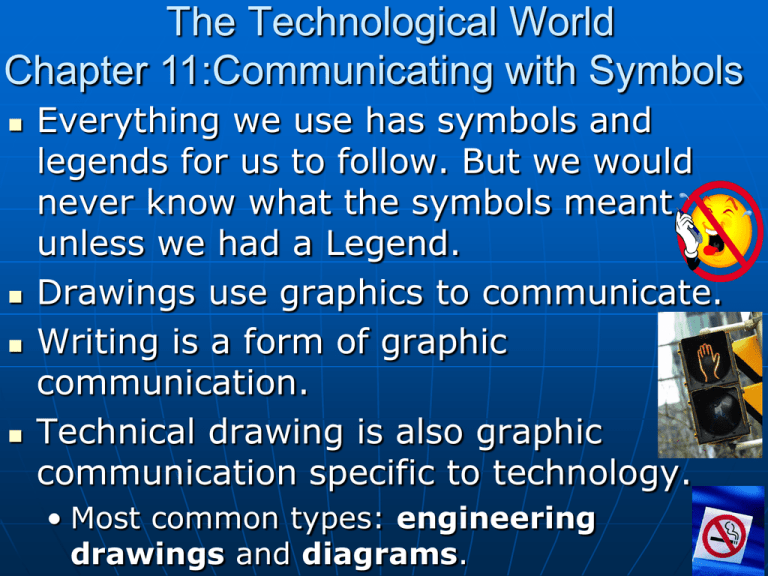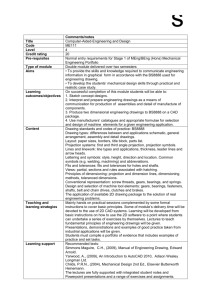File
advertisement

The Technological World Chapter 11:Communicating with Symbols Everything we use has symbols and legends for us to follow. But we would never know what the symbols meant unless we had a Legend. Drawings use graphics to communicate. Writing is a form of graphic communication. Technical drawing is also graphic communication specific to technology. • Most common types: engineering drawings and diagrams. Diagram of pliers Engineering drawing of pliers Technology: is a set of techniques used by humans to design, build and maintain objects and systems that we want or need. 2 Lines and Geometry in Technical Drawings EST AST Before a technical object can be manufactured, its shape and dimensions must be determined. A technical drawing must be created. Technical drawings can be made by hand or on a computer. Technical Drawings: are used in technology to communicate information about an object or a system. Basic and Geometric Lines Basic Lines: used in drafting are lines whose appearance and meaning are determined by international agreements. • Thick lines • Medium lines • Fine lines Types of Lines in Orthographic Projections Construction lines - Basic faint lines which are drawn to provide a framework for the completion of the projection. Dimension Lines display precise information about the size of the object. 10cm Object/Visible Lines – represent visible features for an object. They are the darkest and most present. Hidden Lines – represent features that cannot be seen in the current view. They are as dark as the object lines. Center lines – represent symmetry and mark the center of circles, the axes of cylinders, and the axes of symmetrical parts, such as bolts Section/Cutting Plane Lines Are used to represent where the object is to be “cut” or sectioned to reveal interior details. This is used when other views may not adequately reveal information about the object. A A Construction Lines Construction lines When a drawing is rendered, basic faint lines are drawn to provide a framework for the completion of the projection. Although not part of the object, these lines provide the framework to construct the drawing of the object. Dimension Lines Dimension Lines display precise information about the size of the object. Width Top View Depth Front View Right Side View Height Object/Visible Lines Object Lines Represent features that are only visible in the current view. Extension Line Dimension Line Width Top View Top View Depth Front View Right Side View Height Hidden lines • represent features that cannot be seen in the current view. We show these unseen details, with dashed lines. ALL Hidden or internal details must be included. Top View Front View What does the inside of this block look like? Right Side View Center Lines • represent symmetry and mark the center of circles, the axes of cylinders, and the axes of symmetrical parts, such as bolts. Top View Front View Right Side View Again, though not part of the object, these lines are important elements of the objects dimension and construction. Sectioning of a view A The section line labeled A:A shows the arrows A pointing in the direction to which you are observing the “cut” or section. A A Section Lines Are used to represent where the object is to be “cut” or sectioned to reveal interior details. This is used when other views may not adequately reveal information about the object. Sectional view A:A Geometric Lines Are figures that are composed according to the rules of geometry, the art of drafting lines and curves with a ruler and a compass. Geometric rules and tools allow for: • Horizontal, straight, parallel lines. • Vertical, straight, parallel lines that are perpendicular to the horizontal lines. • Oblique lines. • Circles and Ellipses with defined radii. 2.3 Three Ways of Producing Technical Drawings Freehand: Sketch Drawing with drafting tools (manual drafting instruments) Using drafting software: computer- Sketch, Drafting, & CADs Sketch: Quick illustration of an object that is drawn freehand, respecting, as much as possible, the conventions of drafting. 1st drawings of an object are sketches. 2nd would be the manual drafting instruments’ drawings or CADs. Drawings with Manual Drafting Instruments: used to create very precise technical drawings prior to CADs. 3 Projections A projection is the representation of a three-dimensional object on a twodimensional surface. To understand these drawings, we must be able to recognize and analyze different projections. • Space tech. terminology pg. 343 Projections differ by two aspects: • Position of object with respect to paper. • Angle between the visual rays and paper. EST AST Three of the most commonly used projections are: 1. Multiview 2. Isometric 3. Oblique An Orthogonal Projection is a projection in which all of the visual rays from the object are perpendicular to the surface of a sheet of paper. Projections Orthogonal projections Multiview projections 1 Oblique projections 3 Isometric projections 2 3.1 Multiview Projections In a multiview projection, each face of the object is drawn separately looking at it from straight on. 2D 6 views: • • • • • Front Rear left-side right-side Top • Bottom. EST AST Multiview Projections Usually only the top, front and right side of the object are illustrated; presented in an L-shape. One side of object is always parallel to the paper. All measurements and angles present. Conventional Orthographic Views Each view is constructed so that information (dimensions, and object edges, etc ..), are clearly related to the other views. Width Top View Top View Depth Front View Right Side View Height 3.2 Isometric Projections Is a form of perspective drawing in 3D. Perspective Drawing represents the three dimensions of an object in the same view. An isometric projection is a perspective drawing of an object where the principal edges are arranged on three isometric axes (120° each). No surface of the object is parallel to the paper, measurements parallel to isometric axes are to scale, angles are not. EST AST Isometric Drafting 3.3 Oblique Projections EST AST Is a perspective drawing in 3D. An oblique projection is a perspective drawing in which one of the object’s sides is parallel to the sheet of paper, but its depth is represented by parallel straight lines drawn at an oblique angle. Produce drawings with precise measurements for two dimensions: height and length. Oblique Projections The Use of Projections in Engineering Drawings Multiple projections are combined in the engineering drawings for a project. Most commonly used are: • General drawings • Axonometric Projections: Exploded view drawings • Detail drawings General Drawing: an engineering drawing, shows overall design. Multiview or isometric. Axonometric Projection: parallel projection used to create a 3D drawing, where the object is rotated along one or more of its axes relative to the plane of projection. • Exploded View Drawing: is an engineering drawing that shows the different parts, or features, of the object separately. Usually multiview and isometric projections. Bill of materials: includes name of each part, quantity, and the materials needed for construction. Detail Drawing: is an engineering drawing, specifies the details needed to make a part of an object. Usually a multiview projection. Includes size, position and diameter of holes. General Drawing EST AST Exploded View Detail Drawing 4. Engineering Drawing Scale: is used to reduce or enlarge the representation of an object on a sheet of paper. This is called drawing to scale. Scale reduction: reduce all measurements of an object by the same factor. 1:50 make measurements 50 times smaller. Scale increase: increase all measurements of an object by the same factor. 20:1 make measurements 20 times bigger. Full-size: object represented with its real measurements. 1:1 make the measurements exactly the same size. Drawing’s title block includes: name of draftsperson, title of drawing, date when made, and scale that was used. Scale of 1:2 Dimensional Tolerances EST AST Since machines, tools, instruments, and the operators of machines are not perfect, the manufactured parts may be slightly different from the dimensions indicated on the drawing. A dimensional tolerance is an indicator of the maximum acceptable difference between a specified measurement and the actual measurement on the finished object. Tolerance If the tolerance value applies to the entire drawing then its written in the title block. Dimensioning Refers to the process of indicating the real dimensions of an object as well as the position of various elements of the object. • Use dimension lines and extension lines with symbols. Ex: Ø – diameter of hole • R – radius of circle or curve • - degrees of an angle Cross Sections and Sections Cross section: reveals the interior of an object, exposing its hidden details to view. 1st step: select dimension to imaginarily cut to produce cross-sectional view. • For multiview projection use cutting plane line 2nd step: draw cross-sectional view indicated by the arrows of the cutting plane line. Surface “cut” represented by hatched lines and hidden lines not used. Section: represents a surface in a crosssectional view. Aligned/Revolved Section: is drawn directly on the object represented Offset/Removed Section: is drawn outside of the object represented. It is used when adding a revolved section might overload the drawing and make it harder to understand. Diagrams A simplified representation of an object, a part of an object or a system. Symbols Used in Diagrams Common Types of Diagrams Refer to diagrams of pliers Using appropriate symbols Circuit Diagram



